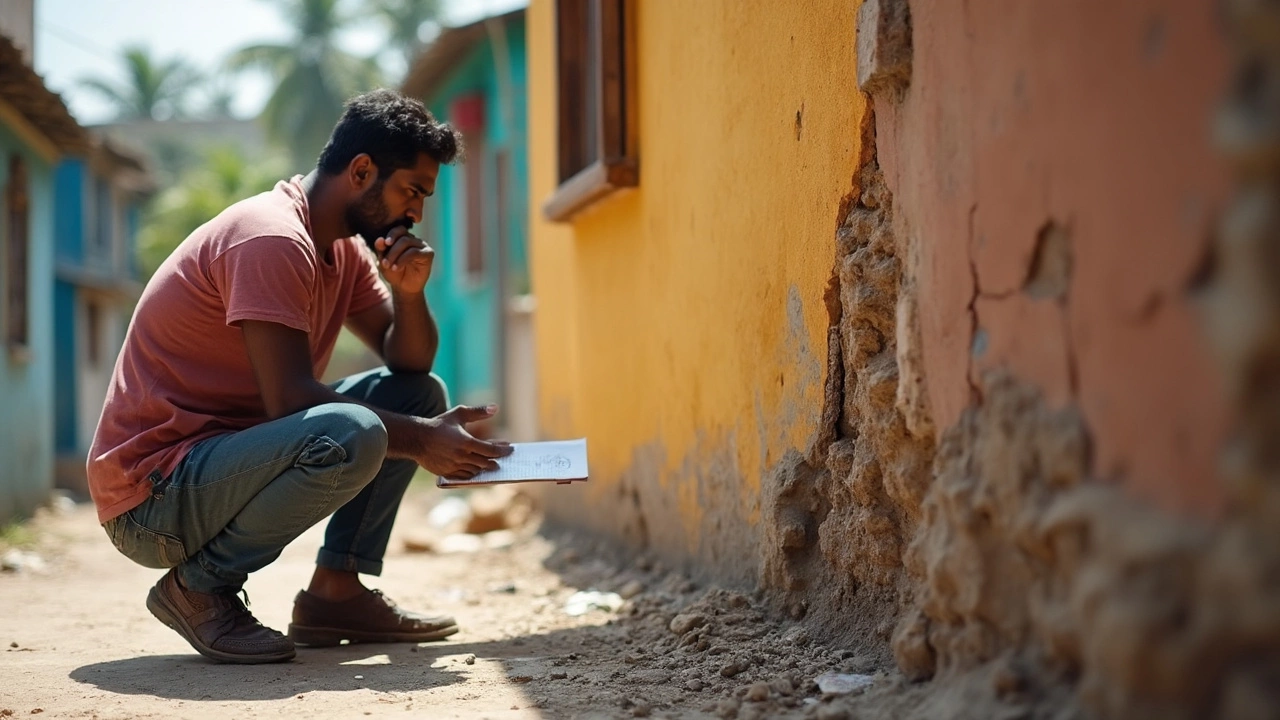Your house feels uneven. Doors won’t shut, cracks split the walls, and you’re wondering if calling a foundation repair crew is just throwing money into a pit. Here’s the thing: sometimes foundation repair works beautifully. Other times, it’s a bandaid on a bigger problem.
Knowing what foundation repair can and can’t do saves you a lot of hassle (and cash). Sure, it can fix the tilting or stop a house from sinking, but it’s not magic—sometimes it’s patchwork. You want to know if fixing it will last or if you’ll be redoing it in a few years.
It comes down to the root of the problem. If your foundation’s sinking because the soil keeps shifting or there’s a leak, repairs can make a night-and-day difference. But if the problem is ongoing and no one fixes the root cause—say, bad drainage or tree roots under your home—repairs can unravel fast.
The trick is figuring out what’s really going on before anyone starts drilling or pouring concrete. Professionals with real experience look at the whole picture: soil type, cracks inside and out, water flow, even old repairs that might have failed. If you can catch issues early, your fix has a way better shot at sticking.
- Why Foundations Fail
- What Foundation Repair Actually Fixes
- Types of Repair Methods
- When Does It Work—and When Not?
- Red Flags and Hidden Issues
- Smart Moves After Repair
Why Foundations Fail
Most people don’t notice foundation problems until cracks and stuck doors show up. But the real trouble often starts where you can’t see it—underground. The main culprit? The dirt under your house. It shifts, shrinks, gets soggy, or dries out, and that beats up your foundation over time.
Here’s what usually knocks a foundation off balance:
- Soil movement: Clay soils stretch and shrink with moisture. When they dry out, they pull away and leave gaps. When they’re soaked, they push and swell. This back-and-forth pushes hard on your foundation.
- Water issues: Poor drainage or plumbing leaks dump extra water near your foundation. All that moisture softens the soil or even washes it away.
- Tree roots: Big trees close to the house drink a lot of water out of the soil, which makes some spots settle while others don’t.
- Poor construction: Sometimes, builders use bad fill dirt or don’t compact the soil enough before building. That loose soil can settle unevenly before you even move in.
Want some numbers? Experts say about 60% of U.S. homes are built on clay-rich soils that move a lot. Regions like Texas and Oklahoma are hit hard every year. Even minor foundation movement—just half an inch—can crack walls and floors.
| Cause | Chance of Causing Issues |
|---|---|
| Clay soil movement | Very High |
| Poor drainage | High |
| Tree roots | Medium |
| Bad fill dirt/poor compaction | Medium |
If your house is in an older neighborhood, you might have another problem: outdated grading and drainage systems. Lots of homes were built before anyone thought much about water control, and it shows decades later. Modern houses try to dodge these problems with better site prep, but nothing’s foolproof.
Bottom line? Everything from where you plant a tree to how your gutters drain rainwater can affect your foundation in a big way. Knowing this stuff early is way cheaper than repairing cracks after they show up.
What Foundation Repair Actually Fixes
If you’re worried about weird cracks, wobbly floors, or doors that stick, this is exactly the kind of thing foundation repair is made to tackle. The main job? To stop your home from moving around any further and fix the damage that's already happened.
Here’s what strong foundation repair usually hits head-on:
- Foundation repair stops settlement—basically, it levels out parts of the house that have sunk.
- It closes up cracks in walls, floors, and ceilings—most repairs get things flush again, and sometimes patch the visible damage, too.
- Sticking doors or windows almost always get better once the house is evened out. You won’t be yanking them open every morning.
- It can straighten up leaning chimneys, porches, or stairways (common when the foundation moves).
Most repairs can’t undo all the cosmetic marks (especially if they’re from years ago), but they stop things from getting worse. Still, don't expect perfection if the problem’s been brewing for a decade.
Some jobs get technical—slab jacking, piering, or wall anchors. These tools are all about moving the house back in line and keeping it there. Contractors pick the method based on your soil, the type of foundation, and how much it's shifted. Here’s a quick look at what repairs address:
| Problem | What Repair Can Do |
|---|---|
| Cracked Foundation Slab | Stabilize, prevent further cracking |
| Uneven Floors | Level the foundation, close gaps |
| Cracked or Bowed Basement Walls | Reinforce walls, prevent collapse |
| Sticking Windows/Doors | Improve alignment, smoother operation |
Quick tip: Good repairs don’t just fix symptoms—they get to the movement underneath your place. If your home still shifts after a repair, that’s a red flag the root issue wasn’t tackled (think bad drainage or soggy soil). So always ask the crew what’s actually getting fixed and how they back it up.
Types of Repair Methods
If you google foundation repair, you’ll see all sorts of fixes. But which ones actually work, and when should you use them? It really depends on what’s going on under your house, but let’s break down the most common methods you’ll run into.
- Piers (Push Piers, Helical Piers): These are long metal rods driven deep into the ground or screwed in until they hit solid soil or bedrock. Once they’re locked in, the house gets lifted or stabilized right on top of them. Homeowners like piers because they’re tough and can deal with heavy, uneven settling. The bad news? They cost more, but they’re usually a permanent fix.
- Slabjacking (Mudjacking): Crews pump a slurry (usually a mix of cement, sand, and other stuff) beneath the sunken slab to essentially lift it back to where it belongs. It’s less invasive and cheaper than piers, but it works best on smaller jobs where the soil hasn’t moved a ton.
- Piling: Concrete pilings or pressed piles are driven into the soil below the foundation. These are a favorite in places with clay soils that move around a lot. Fast to install, but they don’t always work if the soil shifts again later.
- Wall Anchors: These are used for bowing basement walls. Anchors are placed in the yard and attached to rods that pull walls back into place. If you spot walls curving or pushing in, anchors can buy back stability with minimal mess.
- Epoxy or Polyurethane Crack Injections: For minor cracks, injecting resin can seal out water and sometimes help with structural issues. It’s fast and cheap, but won’t fix a bigger underlying problem.
Want to see how folks usually pick? Here’s a quick comparison of real-world use and costs:
| Method | Best For | Average Cost (per pier/foot) | Longevity |
|---|---|---|---|
| Piers | Major settling, heaving | $1,200–$3,000 | 20+ years |
| Slabjacking | Small slab areas | $500–$1,200 | 5–10 years |
| Piling | Clay soil areas | $800–$2,000 | 10–20 years |
| Wall Anchors | Bowing walls | $700–$2,500 | 10+ years |
| Crack Injection | Minor cracks | $200–$500 | 5–10 years |
The best advice? Don’t pick based on price alone. Each method has its spot, and if the wrong one gets used, you’re probably going to see those old problems pop right back up. A solid inspection can save you thousands in the long run.

When Does It Work—and When Not?
Here's the deal about foundation repair: It’s not a guaranteed, one-size-fits-all cure. Sometimes, repair methods like piering or slabjacking work wonders and keep things sturdy for decades. Other times, the fix barely lasts a few years—sometimes just months—if there are bigger, ongoing issues in play.
Repair works well when:
- The soil under your house is stable after repairs. If crews fix grading or drainage (think: French drains or rerouted gutters), the soil is less likely to shift again.
- Trees and heavy shrubs are far away from the house. Their roots suck up moisture and shift soil, which messes with repairs.
- No water leaks or plumbing issues keep feeding the problem. Even small, hidden leaks can undermine new work fast.
- The method matches your foundation type and the actual problem. For example, steel piers work great for deeper, heavy-duty shifts; foam injection is better for small, settled spots.
On the flip side, repairs can flop if:
- The main issue isn’t fixed. If soil keeps washing away because of bad drainage, new cracks can show up soon—sometimes in as little as a year.
- Contractors cut corners or use the wrong solution. For example, patching a big foundation crack with surface epoxy won’t do much long term.
- There’s active soil, like clay, that swells and shrinks with moisture. It can keep moving no matter what’s done.
Check out this quick look at how long common repairs last when matched to the right problem:
| Repair Type | Average Longevity | Notes |
|---|---|---|
| Steel Piers | 50+ years | Best for deep, shifting soil |
| Concrete Piers | 10–25 years | Good with stable soil |
| Foam Injection | 5–10 years | Best for small settlements, not major shifts |
| Wall Anchors | 15–20 years | Keeps bowing walls stable |
Don’t forget about warranties. Legit contractors usually offer at least a 10-year warranty on bigger jobs and will spell out what’s covered (and what’s not). That can be worth more than big promises on the sales pitch.
The upshot? Foundation repair works best when you tackle not just the symptoms but the root cause—think water, trees, and soil. Otherwise, you might be paying again for the same problems down the road.
Red Flags and Hidden Issues
Spotting trouble signs early can save you a lot of money and headaches with foundation repair. Most folks notice cracks in the walls and think that’s all, but issues can hide behind drywall, under floors, or deep in the soil. If you only fix what you see, you might be missing the real problem.
Here’s what you should actually look out for, beyond the usual cracks:
- Doors and windows that stick or won’t latch – This happens when the frame of your house shifts. It’s not just annoying; it signals movement under your home.
- Uneven or sloped floors – Roll a ball and watch where it goes. If it drifts to one spot, you may have hidden settling.
- Moisture in the basement or crawl space – Damp spots, musty odors, or puddles mean water’s getting in, which is a huge enemy for foundations.
- Cracks outside on your home’s brick or stucco – Step outside and do a full walk-around. Zigzag or stair-step cracks can tell you where things are pulling apart.
- Gaps between walls and ceilings or floors – Even small separations can show the house is shifting away from its original position.
Some red flags stay out of sight but cause major headaches later. The big ones come from drainage problems, hidden plumbing leaks, or even tree roots growing too close. If you keep patching cracks but ignoring water pooling near your foundation, odds are good you’ll see more damage soon.
Pro tip: A good foundation specialist should check everything, not just patch the obvious crack. Ask for a full inspection report before you agree to repairs.
If you’re wondering how common these issues really are, here’s a quick breakdown of what home inspectors find most often during foundation checks:
| Issue | Percentage of Homes Affected |
|---|---|
| Minor Wall Cracks | 66% |
| Sticky Doors/Windows | 45% |
| Moisture in Basement | 38% |
| Uneven Floors | 22% |
Bottom line? Don’t let anyone talk you into a quick fix before you know what’s really going on. Take time to check for these hidden problems, and make sure your repair tackles the whole issue—not just the obvious symptoms.
Smart Moves After Repair
Once your foundation is patched up, the job’s not over. The smartest homeowners keep a close eye on the fixes, adjust habits, and protect their investment. Ignoring things after repair is like fixing a leaky roof and leaving the window open in a rainstorm. Regular checks and small changes go a long way to making sure those repairs actually last.
- Foundation repair doesn’t automatically stop new problems from popping up. Set reminders to inspect your home’s perimeter every season. Scan for fresh cracks, doors sticking again, or uneven floors.
- Make sure your gutters and downspouts send water at least six feet away from your foundation. Most foundation problems in the U.S. happen because of poor drainage. Water and soil just don’t mix well under your house.
- Don’t let flowerbeds or mulch creep higher than your foundation slab. Extra moisture close to the walls is bad news. Keep plants, especially big trees, a safe distance from your foundation—at least 10 to 15 feet if you can.
- Consider installing a soaker hose during dry spells if you live in a place with clay soil. This helps keep moisture levels in the soil even (shrink-swell cycles are a classic cause of foundation trouble).
- If your home had slab leaks before, keep an eye on your plumbing. Get annual checks for hidden leaks—water under the foundation is sneaky and super destructive.
| Mistake | Why It’s a Problem | What to Do Instead |
|---|---|---|
| Ignoring new cracks | Small fixes can become big repairs if left unchecked. | Check walls and floors monthly; note any changes. |
| Poor drainage | Water piles up and weakens repaired spots. | Maintain gutters, slope soil away from house. |
| Heavy watering near slab | Overwatering can hurt foundation in wet seasons. | Keep irrigation controlled and balanced. |
| Tree roots too close | Roots dry out soil and shift foundation again. | Plant trees farther away, trim roots if needed. |
If your repair came with a warranty, stash all paperwork where you can find it fast. If trouble pops up, you’ll want proof of what was done and when. And if you notice anything weird or familiar, call your contractor right away—most warranties require quick reporting for coverage to stick.






